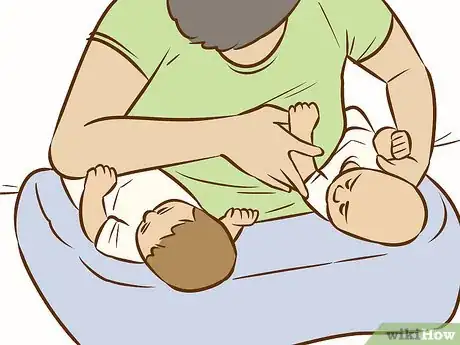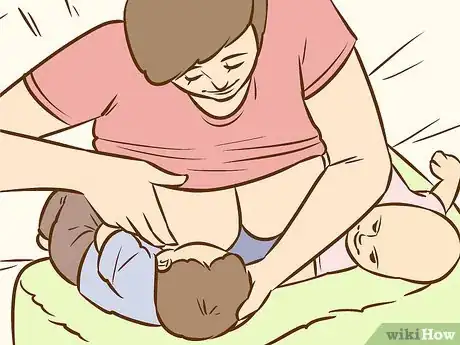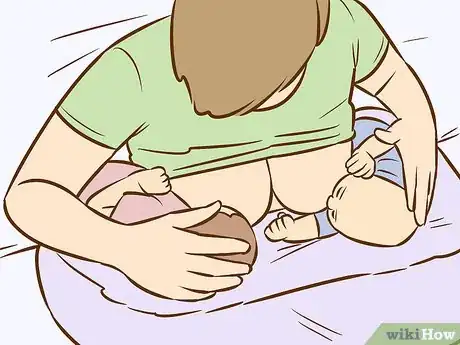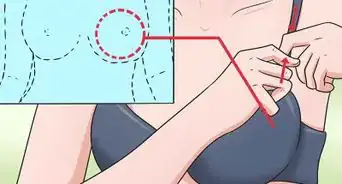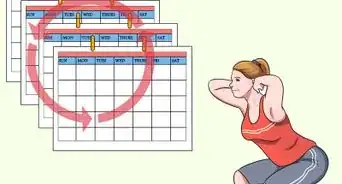This article was co-authored by Lora Luczywo, IBCLC and by wikiHow staff writer, Jessica Gibson. Lora Luczywo is an International board certified Lactation Consultant (IBCLC) based in Los Angeles, California. Lora has over 10 years of lactation consulting experience. She completed her lactation education at the University of California, San Diego and earned her clinical competency at Kaiser Permanente Los Angeles Medical Center and Torrance Memorial Medical Center. She has a BA in Liberal Arts and Sciences from the University of Arizona.
There are 8 references cited in this article, which can be found at the bottom of the page.
This article has been viewed 45,053 times.
Breastfeeding twins comes with its own set of challenges. Fortunately, with a little preparation you can learn one of the most comfortable ways to feed your babies. Learn how to nurse the babies one on one before moving on to tandem (simultaneous) nursing. You can efficiently breastfeed them by setting up a comfortable place, considering a nursing schedule, and using lots of pillow supports.
Steps
Simultaneously Breastfeeding Twins
-
1Set up pillow supports. Sit on your couch, bed, or floor and place a pillow behind your back for support. Put a nursing pillow designed for twins firmly around your waist and set a pillow underneath it for extra support. You can also set single nursing pillows on both of your sides so you can set the babies there once you've finished breastfeeding them.[1]
- You may want to have someone help you get used to setting up the pillow supports and handing you the babies (especially if they're newborns).
- Some double nursing pillows actually strap around your waist.
-
2Arrange the babies next to you on the nursing pillow. You can place the babies in the double football or clutch hold so that one baby is on each of your sides. You should be able to tuck the babies under your arms (like a football). The babies' tummies should be touching your tummy and they shouldn't be on their backs. Their feet should be pointed towards your back and you can support the shoulders, neck, and head with your arm.[2]
- This hold works well for preterm or smaller babies. It's also a good choice if you had a C-section since it keeps pressure off of your stomach.
Advertisement -
3Latch one baby on at a time. Start by latching whichever baby has an easier time of latching on. Once that baby is securely on your breast, help the other baby latch on to the other breast. This will give you a chance to help the baby that might be struggling more to latch on.[3]
- If you have preterm or very young babies, you may want to place a small rolled up cloth right behind their heads. This will give them a little extra support.
-
4Check your babies' positions. If you have a pillow underneath your nursing pillow, your babies should be raised up a little towards your breasts. For simultaneous breastfeeding, their legs should be wrapped around your sides and almost tucked around your back. The babies should be on their sides rather than their backs while they're breastfeeding.[4]
- Your main goal is that they remain latched on and don't roll back or off of the nursing pillow.
-
5Let the babies finish nursing. You don't need to stop and switch breasts as long as both babies are nursing well. You may need to help a baby latch on if it slips off, but give it a chance to keep nursing the same breast. This will ensure that your baby gets the rich hindmilk.[5]
- You may want to alternate babies and breasts on the next feeding or the following day.
Efficiently Breastfeeding Twins
-
1Consider nursing your babies individually. It may help to nurse each twin individually in the early days of breastfeeding, when you and your babies are learning about latching on and positioning. This way you'll be able to spend a little more time and have extra hands to work with one baby at a time.
- Nursing your babies individually can also help you learn about each baby's nursing habits. This can help you when you begin to simultaneously breastfeed them.
-
2Create a nursing schedule. Consider setting a nursing schedule for your twins so you can get them on a feeding schedule. If your babies are very small, work with a doctor or lactation consultant to make a schedule that will give your babies enough milk. For example, you may set an alarm to go off every hour and a half so you know that it's time to feed your twins.[6]
- A schedule can be helpful if you're so tired that you can't remember how long it's been since their last feeding.
- If you'd like to follow your babies' hunger cues and feed them whenever their hungry, just keep track of when you feed them and how long they nursed.
-
3Set up a breastfeeding area. Create a space where you have all the things you'll need while breastfeeding. You should have easy access to anything you'd need during the feeding so you won't have to interrupt the feeding. Ensure that you're comfortable since you'll be spending a lot of time breastfeeding. Consider having these in your breastfeeding area:
- Nursing pillow and support pillows
- Water bottles
- Healthy snacks (such as granola bars, fruit, protein bars)
- Things to read
- Access to entertainment (such as a tablet, television, or laptop)
- Music to listen to
- Diapering supplies (if you need to quickly change one of the babies)
-
4Wear a comfortable nursing bra or clothing to breastfeed in. Choose a nursing bra that you can easily unsnap or unclip with one hand in order to breastfeed. If you choose not to wear a nursing bra, consider wearing a comfortable top that gives you access to your breasts so you don't have to take off your entire top to breastfeed.[7]
- For extra support, look for a nursing bra that contains an underwire. If you'll be simultaneously breastfeeding, ensure that you can easily access both breasts while wearing the bra.
-
5Talk with a lactation consultant. If you're concerned that your babies aren't latching on correctly, are difficult to position, or aren't getting enough milk, contact a lactation consultant. The lactation consultant can watch you breastfeed and identify any problems. They'll help you so that your babies are able to easily nurse on their own. Look for a board certified lactation consultant.[8]
- Find out if your hospital or birth center offers lactation consultants to work with you. You may be able to drop in to a weekly nursing session or have someone come to your home.
- You can also talk to other mothers of twins. Discuss breastfeeding challenges and tricks to make it work for you.
Expert Q&A
-
QuestionIs it hard to breastfeed twins?
 Lora Luczywo, IBCLCLora Luczywo is an International board certified Lactation Consultant (IBCLC) based in Los Angeles, California. Lora has over 10 years of lactation consulting experience. She completed her lactation education at the University of California, San Diego and earned her clinical competency at Kaiser Permanente Los Angeles Medical Center and Torrance Memorial Medical Center. She has a BA in Liberal Arts and Sciences from the University of Arizona.
Lora Luczywo, IBCLCLora Luczywo is an International board certified Lactation Consultant (IBCLC) based in Los Angeles, California. Lora has over 10 years of lactation consulting experience. She completed her lactation education at the University of California, San Diego and earned her clinical competency at Kaiser Permanente Los Angeles Medical Center and Torrance Memorial Medical Center. She has a BA in Liberal Arts and Sciences from the University of Arizona.
International Board Certified Lactation Consultant It can be, but getting support can make it easier. Ask for help if you need it. Breastfeeding two babies can be challenging, so try to have as much support as you can, and clear as much off of your to-do list as possible.
It can be, but getting support can make it easier. Ask for help if you need it. Breastfeeding two babies can be challenging, so try to have as much support as you can, and clear as much off of your to-do list as possible. -
QuestionHow do you feed twins by yourself?
 Lora Luczywo, IBCLCLora Luczywo is an International board certified Lactation Consultant (IBCLC) based in Los Angeles, California. Lora has over 10 years of lactation consulting experience. She completed her lactation education at the University of California, San Diego and earned her clinical competency at Kaiser Permanente Los Angeles Medical Center and Torrance Memorial Medical Center. She has a BA in Liberal Arts and Sciences from the University of Arizona.
Lora Luczywo, IBCLCLora Luczywo is an International board certified Lactation Consultant (IBCLC) based in Los Angeles, California. Lora has over 10 years of lactation consulting experience. She completed her lactation education at the University of California, San Diego and earned her clinical competency at Kaiser Permanente Los Angeles Medical Center and Torrance Memorial Medical Center. She has a BA in Liberal Arts and Sciences from the University of Arizona.
International Board Certified Lactation Consultant There are positions you can try. Meet with a lactation consultant and ask them to show you the optimal positions for tandem feeding. If you can master feeding both of your babies at the same time, it can make a huge difference in your breastfeeding success.
There are positions you can try. Meet with a lactation consultant and ask them to show you the optimal positions for tandem feeding. If you can master feeding both of your babies at the same time, it can make a huge difference in your breastfeeding success.
Warnings
- Depending on the type of breastfeeding pillow you have, the strap on it might be a strangulation hazard for toddlers. Keep it closed and pulled tight when you are not using it. If your toddler knows how to unbuckle the strap, keep the pillow out of reach.⧼thumbs_response⧽
References
- ↑ https://www.youtube.com/watch?v=s0zLu7dAUC4&feature=youtu.be&t=103
- ↑ https://www.babycenter.com/0_positions-and-tips-for-making-breastfeeding-work_8784.bc
- ↑ https://www.youtube.com/watch?v=s0zLu7dAUC4&feature=youtu.be&t=130
- ↑ https://www.youtube.com/watch?v=s0zLu7dAUC4&feature=youtu.be
- ↑ https://kellymom.com/bf/got-milk/basics/foremilk-hindmilk/
- ↑ https://www.twiniversity.com/2014/02/getting-twins-on-a-feeding-and-sleeping-schedule/
- ↑ https://www.twiniversity.com/2012/08/baby-basics-nursing-twins/
- ↑ http://www.parents.com/baby/breastfeeding/problems/lactation-consultant/

